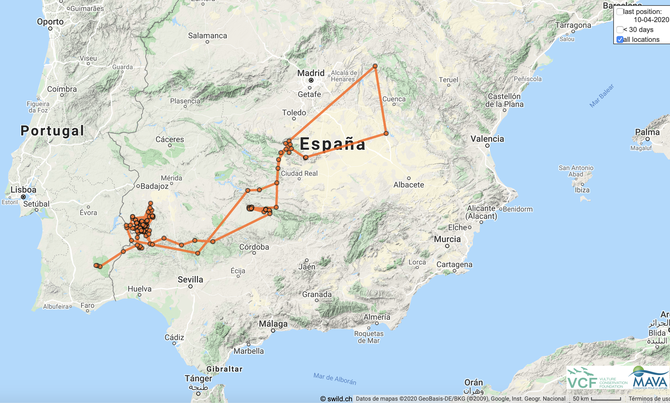
The Cinereous Vulture Caparica was given a second chance in life after it was rehabilitated in the wildlife rescue centre LxCRAS (Portugal) and released back to the wild in the N.P of Guadiana, south Portugal, by the National Institute for Nature Conservation and Forest with the help of us here at the Vulture Conservation Foundation (VCF).
After the release, in mid-September, Caparica directly flew to Spain to the most important Cinereous Vulture colony in Andalusia (southern Spain) with more than 100 breeding pairs, where it spent some days. Then, it continued north arriving at an area where the Spanish NGO AMUS-Acción por el Mundo Salvaje has implemented a project to promote the habitat of the Cinereous Vulture in 18.000 ha, where several estates are involved.
Improving food availability for vultures
One of the actions AMUS undertook was to promote the food availability for the Cinereous Vulture and other scavenger birds in collaboration with local livestock breeders. To do so, they allow the extensive livestock carcasses’ abandonment authorized by the sanitary rules (exclusively sheeps) and the construction of a vulture’s feeding station to deposit other livestock forbidden to be abandoned (mainly goats).
Thanks to this action, the food availability in this area is relatively high, and the presence of Cinereous and Griffon Vultures, as well as Red kites is very common, next to the occasional Spanish imperial eagle.
Caparica’s travels following the release
The food availability and the regular presence of vultures in this area probably attracted Caparica, as it visited one of AMUS’ feeding stations in this area on 5 April. So far in addition to Caparica, 9 Cinereous Vultures, 20 Griffon Vultures, 8 Red kites and 3 Black kites were observed in this feeding station.

Caparica arrived in this area some months ago, at the beginning of November 2019 and left at the end of January 2020, and travelled to central Spain. The bird then returned to this area at the beginning of March, where apparently, it still remains. It’s possible to monitor the movements of Caparica thanks to the GPS transmitter that we provided here at the VCF. Tracking the movements of vultures is an important tool that helps implement accurate conservation actions and will alert us whether Caparica needs help again, and so act accordingly.

Sign up to our newsletter and never miss any vulture news!





